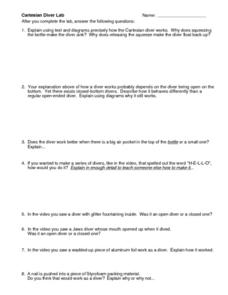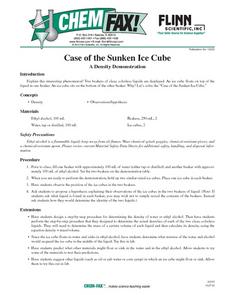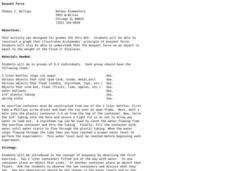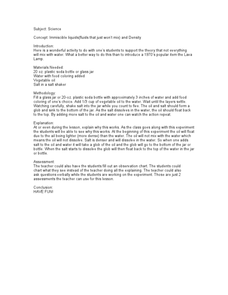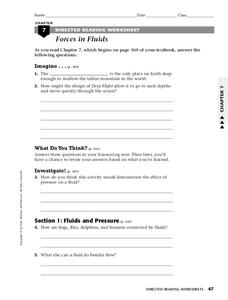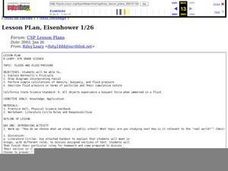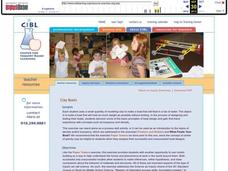Curated OER
Cartesian Diver Lab
In this Cartesian diver lab, students explain using text and diagrams how the Cartesian diver works. Students evaluate ways in making their lab design better. Students make predictions of how changing the variable would change the...
Curated OER
Biocomplexity Lab Activity: Density and Buoyancy of
Students investigate how the density of water changes the buoyancy of
water. Students create a hypothesis about what will happen when placing the
egg into the water.Students can research online different bodies of water (The Red Sea, The...
Curated OER
Chemistry: The Case of the Sunken Ice Cube
Students examine a density demonstration involving ice cubes and beakers of water and alcohol. After observing how one ice cube floats in water and sinks in alcohol, they determine which mixture of the two would suspend the ice cube in...
Curated OER
Floating Vegetables
Students design a craft that safely floats vegetables across a classroom. The teacher provides some materials, but the child may as well. As the experiment is created, they have to fill out worksheets to keep the actiivity organized....
Curated OER
Water Properties of the Great Salt Lake
Fourth graders examine the ecosystem of the Great Salt Lake in this two-part lesson, completing a KWL chart before and after the field trip to the site. While there, they draw and write about their observations. To test for buoyancy,...
Curated OER
Properties of Matter: "Sink or Swim"
Third graders recognize that different materials have different properties which can be observed such as texture and bouyancy, and compare and contrast, through observation, ability of some objects to float because of action of...
Curated OER
Density and Buoyancy Experimental Design
Students must plan, design, and conduct an experiment that answers the scientific question: "Come up with a question that addresses the factors (variables) of the water and its effect on whether an object floats or sinks."
Curated OER
Floating Pencil
Students discover how salt water makes a pencil float better than freshwater by measuring and comparing the lengths of the portion of the pencil that floats above the water surface. They then determine if an unknown water sample is...
Curated OER
Hot Air Balloon
Students view a video and discuss the mechanics of a hot air balloon. They, in groups, construct a functioning hot air balloon.
Curated OER
Earth: The Water Planet
Students elicit data on the water cycle, ocean topography, and island formation in this six lesson unit. The ocean floor and the properties of water are examined through a variety of discussions and hands-on experiments.
Reach Out!
Paper Clip Sailing
Students explain that some things can float on top of water because of what we call "surface tension." They see that if something happens to disturb these water molecules from tugging on each other, the skin-like surface breaks up.
Curated OER
Diving Raisins
Young scholars hypothesize and observe what occurs when raisins are dropped in a carbonated liquid. They examine buoyancy and how density effects ascent and descent.
Curated OER
Concrete Canoes
Learners explore and analyze the relationship of buoyancy and displacement needed to make an object float. They examine various boat designs, then design and build clay and aluminum boats that hold a cargo of marbles.
Curated OER
Technology of the Deep: Experiments with Buoyant Forces
Students conduct a series of experiments to study the effects of temperature and salinity on the buoyancy of an object in water. They devise ways to make floating and sinking objects neutrally buoyant.
Curated OER
Float Your Boat
Learners design an experiment to find density using Archimedes' Principle. In this physics lesson plan, students calculate density using mass and volume. They share their findings in class.
Curated OER
Condiment Diver: The World's Simplest Cartesian Diver
Middle schoolers explain what density is in their own words. In this physics lesson, students perform the condiment experiment and explain why some float and some sink. They share their findings in class.
Curated OER
What Boat Designs Float the Best?
Fifth graders investigate buoyancy by conducting a science experiment. In this water properties instructional activity, 5th graders predict which of their different paper boat designs will float for the longest period. Students conduct...
Curated OER
Buoyant Force
Pupils illustrate Archimedes' Principle of Buoyant Force. In this graphing lesson, students will observe that the buoyant force on an object is equal to the weight of the fluid it displaces. Pupils will then create a graph showing this...
Curated OER
Immiscible Liquids and Density
Students will make a lava lamp. In this density lesson, students will combine water and oil and make observations, then add salt to the oil and observe the oil sink, then float again when the salt dissolves in the water.
Curated OER
Forces in Fluids
In this forces in fluids worksheet, students answer questions as they relate to forces in fluids. Students complete a chart about atmospheric pressure.
Curated OER
Radical Raisins!
Students explore the concept of buoyancy through experimentation. Given materials of various weights and composition, they drop them in club soda and determine which substances sink or float. Students discuss their results in terms of...
Curated OER
Eisenhower 1/26
Eighth graders identify and explain what Bernoulli's Principle is and draw diagrams to incorporate Pascal. They also perform simple calculations of density, buoyancy, and fluid pressure. Finally, 8th graders describe fluid pressure in...
Curated OER
Clay Boats
Seventh graders are given the opportunity to use model-building as a way to help comprehend the forces and phenomena at work in the world around them. They use both successful and unsuccessful models to make inferences, refine...
Curated OER
What Floats Your Boat?
Students discover the Archimedes principle through a buoyancy experiment. They measure the water displacement of a lump a clay which is denser than water then reshape the clay into a bowl which floats but displaces more water.


